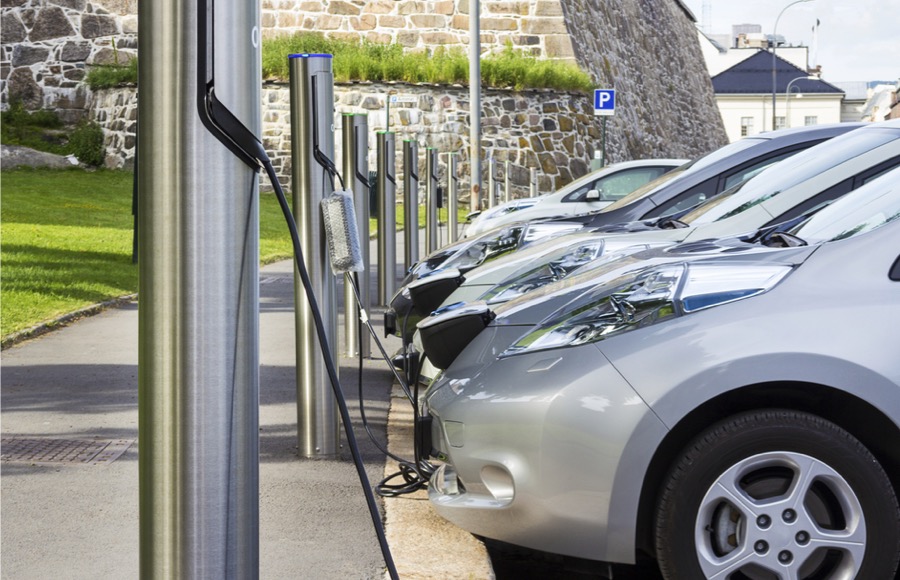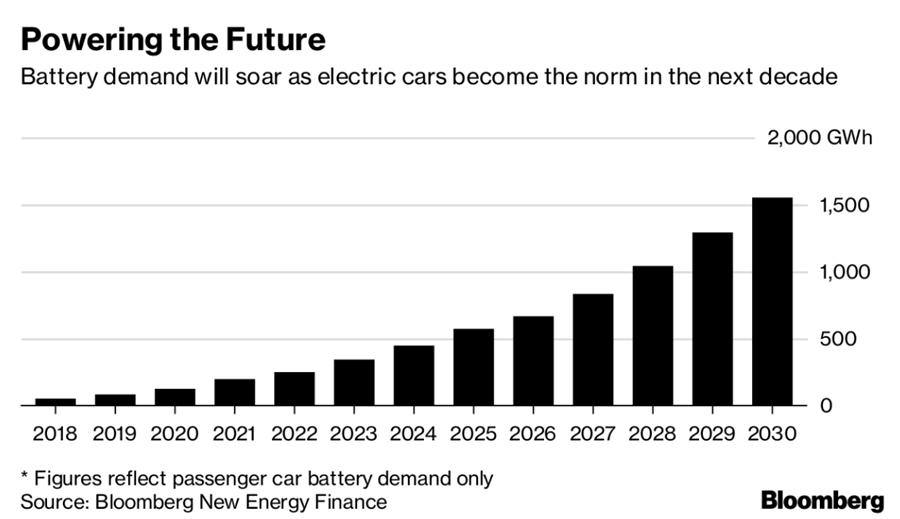The dirt on clean electric cars is just under the hood

Beneath the hoods of millions of the clean electric cars rolling onto the world’s roads in the next few years will be a dirty battery.
Every major carmaker has plans for electric vehicles to cut greenhouse gas emissions, yet their manufacturers are, by and large, making lithium-ion batteries in places with some of the most polluting grids in the world.
By 2021, capacity will exist to build batteries for more than 10 million cars running on 60 kilowatt-hour packs, according to data of Bloomberg NEF. Most supply will come from places like China, Thailand, Germany and Poland that rely on non-renewable sources like coal for electricity.
“We’re facing a bow wave of additional CO2 emissions,” said Andreas Radics, a managing partner at Munich-based automotive consultancy Berylls Strategy Advisors, which argues that for now, drivers in Germany or Poland may still be better off with an efficient diesel engine.
The findings, among the more bearish ones around, show that while electric cars are emission-free on the road, they still discharge a lot of the carbon-dioxide that conventional cars do.
Just to build each car battery—weighing upwards of 500 kilograms (1,100 pounds) in size for sport-utility vehicles—would emit up to 74 percent more C02 than producing an efficient conventional car if it’s made in a factory powered by fossil fuels in a place like Germany, according to Berylls’ findings.
Yet regulators haven’t set out clear guidelines on acceptable carbon emissions over the life cycle of electric cars, even as the likes of China, France and the U.K. move toward outright bans of combustion engines.
“It will come down to where is the battery made, how is it made, and even where do we get our electric power from,” said Henrik Fisker, chief executive officer and chairman of Fisker Inc., a California-based developer of electric vehicles.
For perspective, the average German car owner could drive a gas-guzzling vehicle for three and a half years, or more than 50,000 kilometers, before a Nissan Leaf with a 30 kWh battery would beat it on carbon-dioxide emissions in a coal-heavy country, Berylls estimates show.
And that’s one of the smallest batteries on the market: BMW’s i3 has a 42 kWh battery, Mercedes’s upcoming EQC crossover will have a 80 kWh battery, and Audi’s e-tron will come in at 95 kWh.
With such heavy batteries, an electric car’s carbon footprint can grow quite large even beyond the showroom, depending on how it’s charged. Driving in France, which relies heavily on nuclear power, will spit out a lot less CO2 than Germany, where 40 percent of the grid burns on coal.
“It’s not a great change to move from diesel to German coal power,” said NorthVolt AB CEO Peter Carlsson, a former Tesla manager who is trying to build a 4-billion-euro ($4.6 billion) battery plant in Sweden that would run on hydropower. “Electric cars will be better in every way, but of course, when batteries are made in a coal-based electricity system it will take longer” to surpass diesel engines, he said.

To be sure, other studies show that even in coal-dominant Poland, using an electric car would emit 25 percent less carbon dioxide than a diesel car, according to Transport & Environment Brussels, a body that lobbies the European Union for sustainable environmental policy.
The benefit of driving battery cars in cities will be immediate: their quiet motors will reduce noise pollution and curb toxins like nitrogen oxide, NOX, a chemical compound spewed from diesel engines that’s hazardous to air quality and human health.
“In downtown Oslo, Stockholm, Beijing or Paris, the most immediate consideration is to improve air quality and the quality of life for the people who live there,” said Christoph Stuermer, the global lead analyst for PricewaterhouseCoopers Autofacts.
But electric cars aren’t as clean as they could be. Just switching to renewable energy for manufacturing would slash emissions by 65 percent, according to Transport & Environment. In Norway, where hydro-electric energy powers practically the entire grid, the Berylls study showed electric cars generate nearly 60 percent less CO2 over their lifetime, compared with even the most efficient fuel-powered vehicles.
As it is now, manufacturing an electric car pumps out “significantly” more climate-warming gases than a conventional car, which releases only 20 percent of its lifetime C02 at this stage, according to estimates of Mercedes-Benz’s electric-drive system integration department.
“Life-cycle emissions in electric vehicles depend on how much the car is driven in order to get to a point of crossover on diesels,” Ola Kallenius, the Daimler AG board member who will take over as CEO next year, said at the Paris Motor Show this month. “By 2030, the life cycle issue will improve.”
Some manufacturers have heeded calls to produce batteries in a more sustainable way. Tesla uses solar power at its Gigafactory for batteries in Nevada, and has plans for similar plants in Europe and Shanghai. Chinese firm Contemporary Amperex Technology Co. is also looking to power its future German plant with renewables.
“The topic of CO2 lifetime evaluations is starting to get more traction,” said Radics at Berylls. “Carmakers need to be transparent in this discussion to avoid unsettling buyers.”
(By Niclas Rolander, Jesper Starn and Elisabeth Behrmann)
More News
Peabody Energy reviewing options related to deal with Anglo American
Last year, Anglo American agreed to sell some of its Australian steelmaking coal mines to Peabody for $3.78 billion in cash.
April 08, 2025 | 03:29 pm
Trump signs executive order to help revive dying coal sector
US president also instructed the Interior Department to locate coal deposits on federal lands, remove barriers to mining, and fast-track leasing processes.
April 08, 2025 | 02:32 pm
US envoy sees Alphamin reopening Congo tin mine as rebels depart
Alphamin halted mining last month at its Bisie mine to protect its employees as M23 rebels neared the site.
April 08, 2025 | 01:51 pm
{{ commodity.name }}
{{ post.title }}
{{ post.excerpt }}
{{ post.date }}




Comments